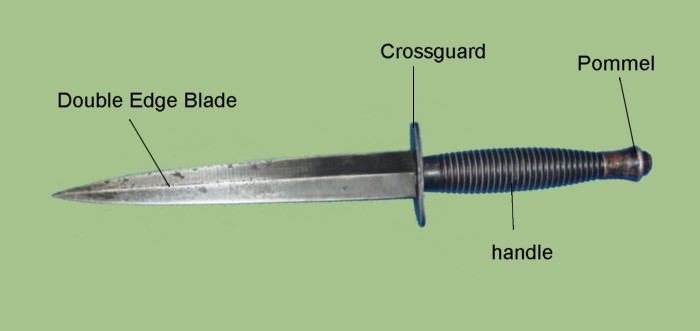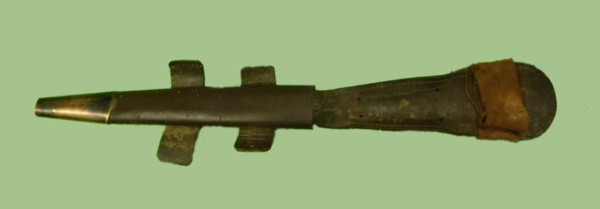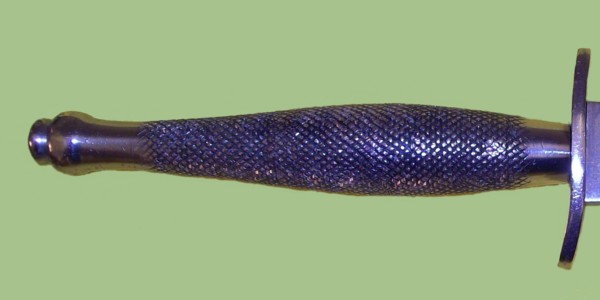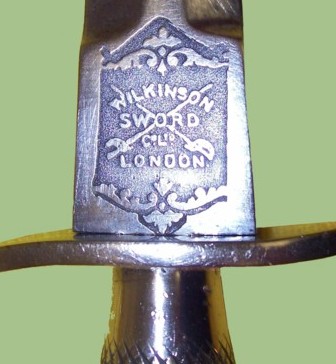THE HISTORY OF THE FAIRBAIRN & SYKES FIGHTING KNIFE
Knives have been a key fighting weapon in every war. No matter how advanced the technology, a good knife always has a place in battle.
A special breed of knives saw extensive development during WWII. Known as the "fighting knife". While it could be employed for the uses of a regular knife, its primary goal was for hand-to-hand combat. The design, balance and materials employed varied from the run of the mill knife.
This page provides a sample of the various Faibairn-Sykes fighting knives used during WWI and beyond. The samples
displayed here cover various countries that participated in the war. Information provided includes the identification
of fighting knives and pricing of fighting knives.

There were different types of scabbards that were issued with the Fairbairn and Sykes knife. The one featured here is a
WWII version. Of leather construction. The main body has four leather flaps that extend from it, teo on each side.
These flaps allowed the scabbard to be sewn to a surface. For example, the scabbard could be attached to the inside of
an overcoat or jacket.

The tip of the scabbard was covered with a brass fitting. The upper section tapers out into a semi-circular form.
A separate strap is sewn in place to secure the handle of the knife when it is inside the scabbard. The color is
brown but it also came in black.
FAIRBAIRN - SYKES KNIFE TYPES
The Fairbairn-Sykes was produced in several patterns. Some of them are discussed in this section of the website.
The Shanghai knife, which was the starting design point for the Fairbairn-Sykes famnily,
had a very short blade. It was only about 5.5 inches in length.
First pattern knives have a 6.5 inches blade with a flat area, or ricasso, at the top of the blade which was not present on the original design and the presence of which has not been explained by the manufacturers, under the S-shaped crossguard.
The Second-pattern knives have a slightly longer blade (just less than 7 inches), 2 inches-wide oval crossguard, knurled pattern grip, and rounded ball, and may be stamped "ENGLAND" on the handle side of the cross piece. Some may also be stamped with a number (e.g., 21) on the opposite handle side of the cross piece. Above the number may also be stamped a triangular symbol. Third-pattern knives also have a similarly-sized inch blade, but the handle was redesigned to include a ring grip. This ring grip is reputed to have distressed one of the original designers as it unbalanced the weapon and made harder to hold when wet, but it was used by the manufacturers as it was simple to produce.
Third-pattern knives may be stamped "WILLIAM RODGERS SHEFFIELD ENGLAND", "BROAD ARROW", or simply "ENGLAND". William Rodgers, as part of the Egginton Group, now also produce an all-black "sterile" version of the knife, which is devoid of any markings showing maker or NATO use. It has also been finely balanced for throwing.
THE FAIRBAIRN - SYKES KNIFE IN THE UNITED STATES
The U.S. Office of Strategic Services's per-knife manufacturing bid was approximately one-fifteenth of the cost of the British version. The U.S. version was of inferior materials and workmanship. Its reputation suffered accordingly. Furthermore, U.S. Marines were improperly trained in using the knife. They complained of malfunction and of limited attack opportunity; however, it was not a utility knife. Fairbairn did have the opportunity to properly train soldiers in the correct use of his fighting knife.
British Major Fairbairn, who had been chief of police in Shanghai before the Japanese capture of the city, taught the Fairbairn method of assault and killing. His course was later given at OSS camps in the United States. many of the individuals who were taught by Major Fairbairn reported that he had an honest dislike for anything that smacked of decency in fighting. He was
a true street fighter.
In contrast to the OSS version where some 20,000 were produced, the British knives numbered close to two million units,
however, not all of them were of equal quality. post-War versions show many problems with construction.
Early production runs of the knife were extremely limited and demand was high as British soldiers attempted to buy their own.
FAIRBAIRN AND SYKES KNIFE CROSSGUARD MARKINGS
Many of the knives had markings on the crossguard. The markings were stamped on the top or bottom sections of the
guards. The information that was stamped often included the country of origin, name of the manufacturer, and more.
FAIRBAIRN AND SYKES KNIFE ADDITIONAL MARKINGS
The knives may have been marked in areas othet than the crossguard. Some of the knives had informatin stamped in the pommel,
base of the handle, blade and other parts. This section illustrates some of the markings.
The picture on the left shows a number 2 in the pommel. The photo in the center has a number 8 with a broad arrow
symbol on top. The picture on the far left shows the ricasso of the blade stamped with "Steel Products".
THE F-S KNIFE
The first batch of fifty F-S Fighting Knives were produced in January 1941 by Wilkinson Sword Ltd after Fairbairn and Sykes had traveled down to their factory from the Special Training Centre at Lochailort in November 1940 to discuss their ideas for a fighting knife.

The F-S Fighting Knife was designed exclusively for surprise attack and fighting, with a slender blade that can easily penetrate a ribcage. The vase handle grants precise grip, and the double-edged blade is integral to its design. Fairbairn's rationale is in his book Get Tough! (1942).
"In close-quarters fighting there is no more deadly weapon than the knife. In choosing a knife there are two important factors to bear in mind: balance and keenness. The hilt should fit easily in your hand, and the blade should not be so heavy that it tends to drag the hilt from your fingers in a loose grip. It is essential that the blade have a sharp stabbing point and good cutting edges, because an artery torn through (as against a clean cut) tends to contract and stop the bleeding. If a main artery is cleanly severed, the wounded man will quickly lose consciousness and die."

In all the different variations of the knife the handle had a distinctive foil-like grip to enable a number of handling options. Many variations on the F-S Fighting Knife exist in regards to size of blade and particularly of handle. The design has influenced the design of knives throughout the many decades since its introduction.
 |
The length of the blade was chosen to give several inches of blade to penetrate the body after passing through the 3 in (7.6 cm) of the thickest clothing that was anticipated to be worn in the war, namely that of Soviet greatcoats. Later production runs of the F-S Fighting Knife have a blade length that is about 7.5 in (19 cm).
F-S KNIFE MARKINGS
The base of the blade is marked on both sides. One side reads "Wilkinson Sword, London", which indicates the company
that manufactured the knife and its location. Two swords are crossed at the center of the marking.
The other side reads "F-S, Fighting, Knife". The F-S stands for Fairbairn and Sykes. The rest is a descriptionof the type
of knife this is.
Both sets of markings are found inside a carved section with decorations above and below the actual markings.
|
This information is brought to you courtesy of
MilitaryItems.com . a premiere provider of
military antiques and collectibles.
If you have an interest is seeing other fighting knives, you can do so by going to our
Military Fighting Knives Price Guide
identification page. Where we cover Army, Navy, Army Air Force, USMC and other military groups.
While the knives shown on this page are not for sale, you can visit our website,
MilitaryItems.com ,
to see other military and non-military knives available for sale.
|







